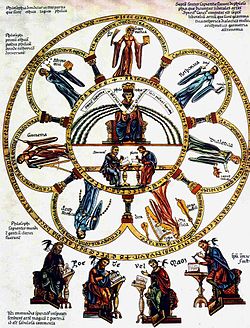Liberal arts education: Difference between revisions
I've changed the Latin term - it should be |
I've changed the Latin term - it should be liber instead of libera |
||
| Line 6: | Line 6: | ||
==History== |
==History== |
||
===Definition{{anchors|Seven liberal arts|The seven liberal arts}}=== |
===Definition{{anchors|Seven liberal arts|The seven liberal arts}}=== |
||
The term 'liberal arts' is a college or curriculum aimed at imparting general knowledge and developing intellectual capacities, in contrast to a [[professional]], [[vocational|vocational, or technical]] curriculum. In [[classical antiquity]], the term designated the education proper to a freeman ([[Latin]]: '' |
The term 'liberal arts' is a college or curriculum aimed at imparting general knowledge and developing intellectual capacities, in contrast to a [[professional]], [[vocational|vocational, or technical]] curriculum. In [[classical antiquity]], the term designated the education proper to a freeman ([[Latin]]: ''liber'', "free") as opposed to a [[Slavery in ancient Rome|slave]]. [[Martianus Capella]] (5th century AD) defines the seven Liberal Arts as grammar, dialectic, rhetoric and geometry, arithmetic, astronomy, music. In the [[Medieval university|medieval Western university]], the seven liberal arts were: |
||
* [[trivium (education)|the ''Trivium'']] |
* [[trivium (education)|the ''Trivium'']] |
||
<ol> |
<ol> |
||
Revision as of 05:15, 5 September 2008

The term liberal arts refers to a particular type of educational curriculum broadly defined as a classical education. Template:TOCnestright
History
Definition
The term 'liberal arts' is a college or curriculum aimed at imparting general knowledge and developing intellectual capacities, in contrast to a professional, vocational, or technical curriculum. In classical antiquity, the term designated the education proper to a freeman (Latin: liber, "free") as opposed to a slave. Martianus Capella (5th century AD) defines the seven Liberal Arts as grammar, dialectic, rhetoric and geometry, arithmetic, astronomy, music. In the medieval Western university, the seven liberal arts were:
In modern colleges and universities, the liberal arts include the study of art, literature, languages, philosophy, history, mathematics, and science.[1]
Expansion to include visual arts
During the Renaissance a considerable propaganda campaign was mounted to support the promotion to the number of liberal arts of architecture, painting and sculpture, though not necessarily for their inclusion in the educational curriculum in the same way. Previously they had been classified among the mechanical or manual arts. Among those writing to support their inclusion were Leon Battista Alberti, Leonardo da Vinci, Giorgio Vasari and many others. At least in Italy, and among Renaissance humanists, the battle was largely won by about 1500,[2] though in remoter regions like Spain and England the process took up to another century.
Liberal arts colleges
Liberal arts colleges are institutions which place a particular emphasis upon undergraduate study in the liberal arts. Generally, a full-time, four-year course of study at a liberal arts college leads students to a Bachelor of Arts or Bachelor of Science degree. Liberal arts colleges have traditionally emphasized interactive instruction[citation needed] (although research is still a component of these institutions) and are usually residential.[citation needed] They typically have a smaller enrollment, class size, and higher teacher-to-student ratios than universities. These colleges also encourage a high level of teacher-student interaction at the center of which are classes taught by full-time faculty rather than graduate student teaching assistants (who teach some classes at Research I and other universities).[citation needed] Although the genesis for what is known today as the liberal arts college began in Europe, [3] the term is commonly associated with liberal arts colleges in the United States. Liberal arts colleges are found in countries all over the world as well[citation needed].
Following completion of their undergraduate studies at liberal arts colleges, students may continue on to graduate study in other institutions, such as professional schools (for instance, in business, law, medicine, or theology) or graduate schools.
References
- ^ "Liberal Arts: Encyclopedia Britannica Concise". Encyclopedia Britannica.
- ^ Blunt, Anthony, Artistic Theory in Italy, 1450-1660,p. 49, 1940 (refs to 1985 edn), OUP, ISBN0198810504
- ^ Harriman, Philip (1935). "Antecedents of the Liberal Arts College". The Journal of Higher Education, Vol. 6, No. 2 (1935), pp. 63-71.
{{cite web}}: Italic or bold markup not allowed in:|publisher=(help)
Further reading
- Blaich, Charles, Anne Bost, Ed Chan, and Richard Lynch. Defining Liberal Arts Education. Center of Inquiry in the Liberal Arts, 2004.
- Blanshard, Brand. The Uses of a Liberal Education: And Other Talks to Students. (Open Court, 1973. ISBN 0-8126-9429-5)
- Friedlander, Jack. Measuring the Benefits of Liberal Arts Education in Washington's Community Colleges. Los Angeles: Center for the Study of Community Colleges, 1982a. (ED 217 918)
- Joseph, Sister Miriam. The Trivium: The Liberal Arts of Logic, Grammar, and Rhetoric. Paul Dry Books Inc, 2002.
- Pfnister, Allen O. "The Role of the Liberal Arts College." The Journal of Higher Education. Vol. 55, No. 2 (March/April 1984): 145-170.
- Reeves, Floyd W. "The Liberal-Arts College." The Journal of Higher Education. Vol. 1, No. 7 (1930): 373-380.
- Seidel, George. "Saving the Small College." The Journal of Higher Education. Vol. 39, No. 6 (1968): 339-342.
- Winterer, Caroline.The Culture of Classicism: Ancient Greece and Rome in American Intellectual Life, 1780-1910. Baltimore: Johns Hopkins University Press, 2002.
- Wriston, Henry M. The Nature of a Liberal College. Lawrence University Press, 1937.
